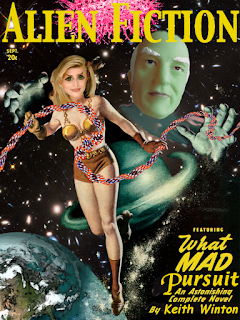 |
| The Perfect Host cover art by Michael Dashow |
 |
| August 1985 |
One of the stories mentioned in that essay is Asimov's robot story "Galley Slave". Apparently Asimov was not fond of the drudgery of correcting pre-publication galley proofs. "Galley Slave" is about a proof-reading robot who gets accused of altering the text of a book just before publication.
 |
| genes in fiction (source) |
 |
| memes |
Biological evolution by means of propagating genes through organisms was one of the great discoveries of previous millennium. In 1976, Dawkins coined the term "meme" to refer to units of cultural information transmission that can evolve by propagation through minds.
The analogy between propagating genes that control the physical structure of organisms and propagating ideas shared by human brains was already recognized back in the 1800s when biological evolution was first recognized as a foundational concept in biology.
 |
| Hawkinsite |
 |
| Rule of Three |
The November 1948 issue of Weird Tales included a story called The Perfect Host , a novella by Theodore Sturgeon. (PDF) The narrative structure of 'The Perfect Host' is unusual. Parts of the story are told by a series of narrators, culminating in one section of the story labelled "Theodore Sturgeon".
 |
| in the Ekcolir Reality Original cover art by Don Sibley |
The first time I was ever exposed to this kind of "jumping consciousness" plot in a science fiction story was in a Star Trek episodes such as "Wolf in the Fold" and "Day of the Dove", two episodes that I immediately despised. Even when I was just 10 years old I was dismayed: how could a mind become disembodied?
Special thanks to Miranda Hedman for the DeviantArt stock photograph "Black Cat 9 - stock" that I used to create the white haired "sedronite" who is in the image to the left.
 |
| in the Ekcolir Reality Original cover art by Edward Valigursky |
Sturgeon's short story 'Rule of Three' was published in Galaxy Science Fiction, January 1951 (download). Science fiction was far enough off the literary focus of attention that authors had special freedom to explore "forbidden" ideas. Sturgeon could question why it is that people are condemned for not building their lives around conventional social structures like one man-one woman marriage.
 |
| "Hostess" interior art by Edmund Emshwiller |
The editor of Galaxy wanted to publish 'Hostess', but first Asimov had to re-write his story so as to make it seem more clearly distinct from Sturgeon's story before it could be published in Galaxy Science Fiction in May 1951 (see this review.)
 |
| "Hostess" interior art by Edmund Emshwiller |
We must wonder to what extent Asimov's "3 in 1" aliens in his novel The Gods Themselves might owe their existence to Sturgeon's aliens in 'Rule of Three'. I suppose the idea of "three spirits in one" has been explored many times in Western literature, if for no other reason than the strong influence of Christian doctrines.
Where Sturgeon could only write into his stories biological nonsense (such as "energy virus"), Asimov's story "Hostess" is full of wonderful biological concepts. Firstly, Asimov posits that all the intelligent species of the galaxy are made of the same sorts of molecules, in particular, proteins coded for by nucleic acid sequences. The alien visitor to Earth, Dr. Tholan, is shown enjoying food such as Earthly tomatoes.
 |
| alien DNA |
Asimov's idea was that an infection could spread from humans to aliens, causing death. Rather than attribute this infectious disease to either bacteria or viruses, Asimov proposed a new type of disease agent, a "parasite" residing within chromosomes, hidden among the genes. Eventually, science caught up with Asimov's imagination. The enzyme reverse transcriptase was found which allows retroviral gene sequences to be inserted into chromosomes.
 |
| source |
Asimov could not be satisfied with just conceiving the existence of retroviruses. For "Hostess" he went on to imagine that the mysterious infectious agents residing in our chromosomes were endosymbionts, able to control human behavior. This was an audacious idea, truly "selfish DNA".
In the Exode Saga, the unseen endosymbionts within us are imagined to be composed of invisibly small sedrons.
Related Reading: more Sci Fi from Sturgeon.
Next: Asimov's Neanderthal
 |
| visit the Gallery of Book and Magazine Covers |






































